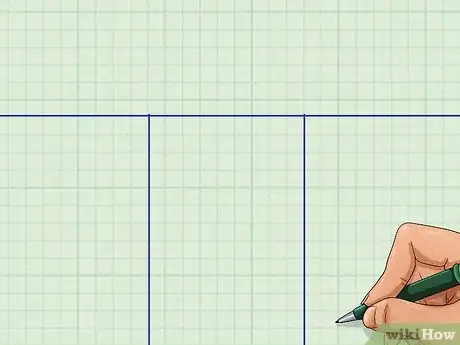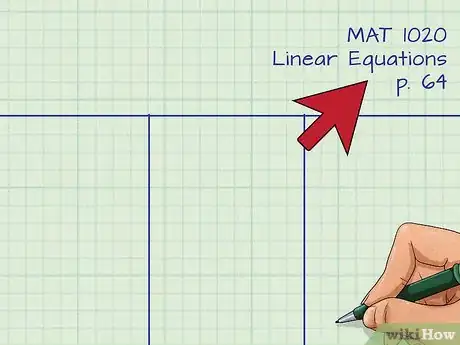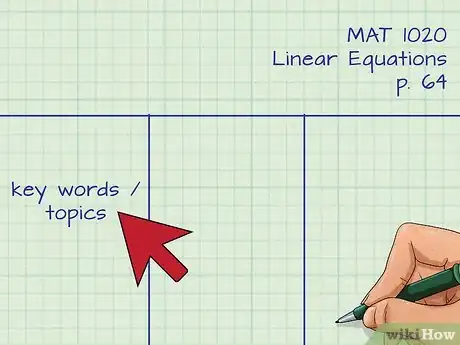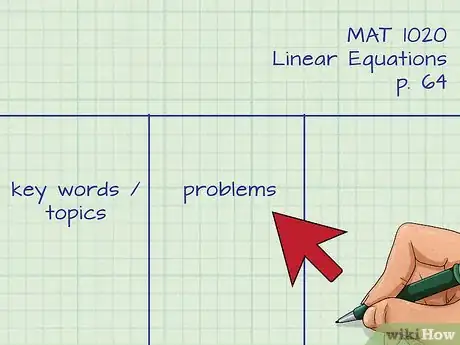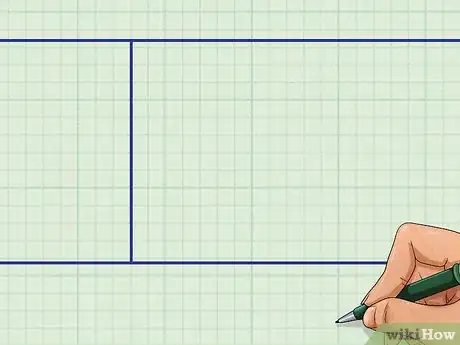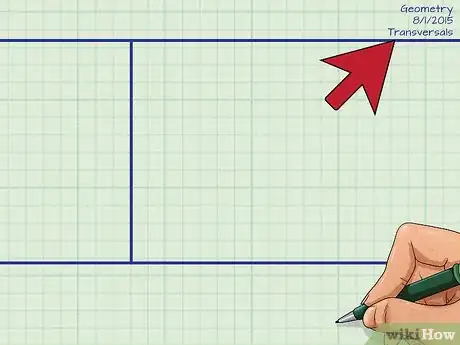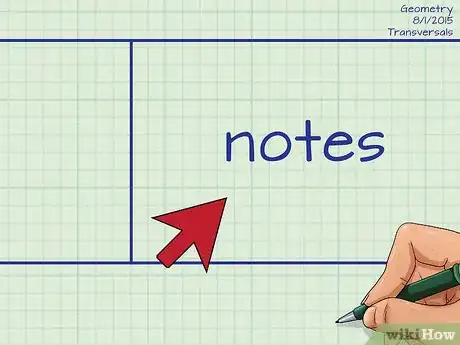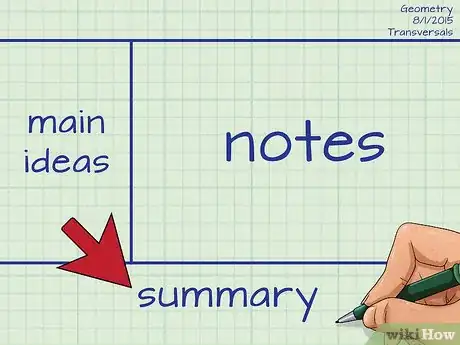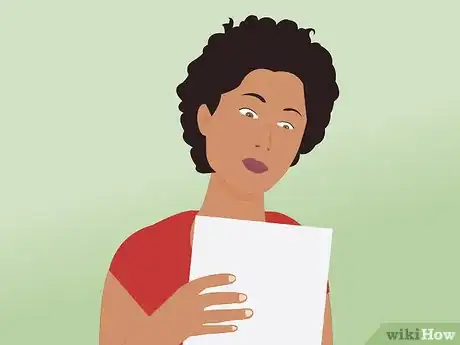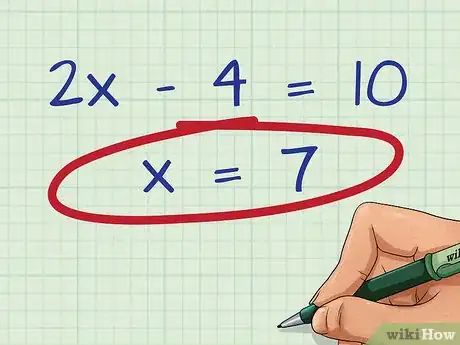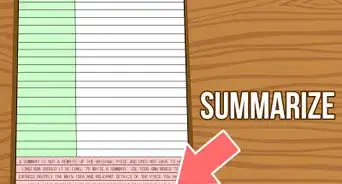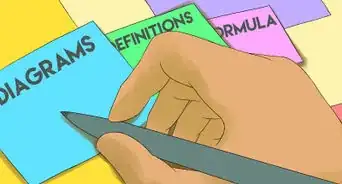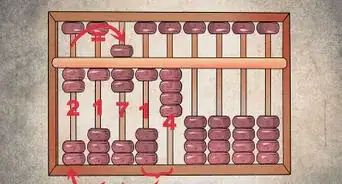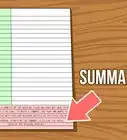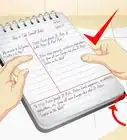This article was co-authored by Daron Cam. Daron Cam is an Academic Tutor and the Founder of Bay Area Tutors, Inc., a San Francisco Bay Area-based tutoring service that provides tutoring in mathematics, science, and overall academic confidence building. Daron has over eight years of teaching math in classrooms and over nine years of one-on-one tutoring experience. He teaches all levels of math including calculus, pre-algebra, algebra I, geometry, and SAT/ACT math prep. Daron holds a BA from the University of California, Berkeley and a math teaching credential from St. Mary's College.
There are 11 references cited in this article, which can be found at the bottom of the page.
wikiHow marks an article as reader-approved once it receives enough positive feedback. In this case, 88% of readers who voted found the article helpful, earning it our reader-approved status.
This article has been viewed 145,963 times.
Taking good notes can help you to retain information you go over in class and can be an invaluable study aid when preparing for tests or exams. It’s important to find the method of note taking that best compliments your study habits and the way you think. Perfect math note taking may be different for you than for others, but some elements are fairly universal. Make sure to pay close attention in class and ask questions when you are unsure of something, then try a few different note taking methods until you find the one that’s just right for you.
Steps
Three Column Method
-
1Divide your pages into three equal columns. Unlike the Cornell Method of note taking, the three column method is designed specifically for use in math classes. You will use each column for different kinds of content in order to better organize your notes.[1]
- Draw two lines from the top of the lined section of the page to the bottom with a ruler, diving the page into three sections.
- You may want to use a marker or different colored ink when drawing your dividing lines in order to help them stand out.
-
2Title each page clearly. You will need to write information at the top of each page to make it easier to locate the sections you are looking for and organize the material. Use the area at the top of the page to write the following information for future reference:[2]
- Course Title
- Topic
- Page number (if there is a coinciding page in your text book)
Advertisement -
3Use the left column for key words and topics. The left hand column of your notes should be reserved only for main points that you can associate with content in the following two columns. Keep the notes you take in the left hand column brief. Think of it as subject headers.[3]
- Notes in the left hand column should be short and provide a title of sorts for information you’ll be writing in other columns.
- You may want to record formulas in the left column that coincide with ones you use when writing problems in the middle column.
-
4Copy math problems in the middle column. Use the middle portion of the page only to copy or work on math problems. When copying math problems off of the board, make sure to write down each step your teacher uses, so you can go back and model your work after it in the future. When doing the problems yourself, ensure you don’t omit steps you complete in your head, so you can refer to it again if you forget how in the future.[4]
- Mark math problems you are unsure of with a question mark, then ask your teacher or a friend with help with them during or after class.
- Make sure to align your work with the appropriate title or main points in the left hand column.
-
5Take notes in the right column. The remaining column will be used to take down notes that explain steps, or help you to better understand the topics and problems covered in the other two columns. Use your own words to describe what you did to complete a problem.[5]
- The right hand column can be used to write down anything you feel you need to remember.
- Try to keep the information in each column aligned with the corresponding material in the other columns.
Cornell Method
-
1Divide your pages into three sections. The Cornell Method of note taking involves organizing information into three sections. Dividing your note sheets makes it easier to write down and to retain information for when you take a test. You may want to use a marker to draw the lines that divide your page to make them easier to see while note taking.[6]
- Draw one horizontal line across your page five lines from the bottom.
- Draw one horizontal line across the top line of the page.
- Draw a vertical line connecting the two about two inches from the left margin.
-
2Label the top with the course name, date and topic. When reviewing your notes, it will be easier to identify the sections you want to focus on if you write large, bold titles at the top of each page. The title section should be written across the top line you drew, and include the name of the class you’re taking notes in, the date, and the topic you are covering in class that day. Some examples of a title section would read:[7]
- Algebra 1 – 6/4/2016 - Two-variable Linear Equations
- Geometry – 8/1/2015 – Transversals
- Calculus – 10/10/2014 – Chain Rule
-
3Take notes in the large box on the right. During the class, take short hand notes by copying main points your teacher writes on the board or writing important things your teacher says. Try to use abbreviations where possible to reduce how much you have to write, and leave a blank space between each new idea. This is also where you will copy down or work on math problems. Try to keep each topic and the math equations they involve together in your notes. Leave the other boxes blank during class.[8]
- Keep your notes brief and simple. Only write as much as you need to in order to remember the main points.
- All of your note taking in class will be within that large box on the page.
-
4Review your notes after class to pull out the main points. After class, sit down and go over your notes again while the information is still fresh in your mind. As you read through them, identify the main ideas, points, dates or topics in your notes and list them in the left column you created with the vertical line.[9]
- Try to list the main points in the left column alongside where the notes relating to them are in the box on the right.
- If you need to, draw lines connecting the main points to the notes relating to them.
-
5Summarize the main points of each page in the bottom box. Below the bottom horizontal line, summarize the material you took notes on above. Use your notes, as well as the main points you wrote on the left to help you.[10]
- Writing a summary of the information on each page will help you to recall the content in the future.
- You can read the summaries to help you find specific topics in your notes, or as a study aid.
-
6Review your notes. When you complete the summary of your main points, look back over your notes and make sure you didn’t leave anything out. Your notes should have main topics, important terms, and formulas in the left hand box, your in-class notes in the right, and a summary of the material covered on the bottom of the page.[11]
- The left hand box might say things like, “Linear Equations,” as well as an example such as “ax+b=0.”
- The right hand box would contain all of the notes you took in class, including any equations you solved.
- The summary box at the bottom may say something along the lines of, “ax+b=0 is considered the standard form, and not all equations will start as such. The variable could be X, but may be indicated as a different letter.”
Improving Your Note Taking
-
1Ask questions when needed. If you aren’t certain about something your teacher said, or didn’t understand the way something was presented, make sure to raise your hand and ask for clarification.[12] The best notes in the world can’t help you if you don’t understand what you’re taking notes on. Remember that the objective is to learn, so don’t be afraid to ask questions.[13]
- Some professors may ask for you to hold your questions until after the lecture. Make sure to write them down to help you recall what you wanted to ask when the time comes.
- If you aren’t comfortable speaking in front of the class, try approaching your teacher after class to clarify things you are unsure of.
-
2Identify important elements of the lecture.[14] In order to take effective notes, you will need to learn to pick out the important portions of what your teacher or professor says during their lecture. Disregard conversational material and focus on things your teacher places an emphasis on during class. Make sure to make note of any new topic, questions you have, and anything the teacher places a large emphasis on while covering the course material.[15]
- If there was assigned reading prior to the class, make note of anything covered in the lecture that differs from how it was presented in the book. Your teacher likely wants you to follow the methodology taught in class.
- Things teachers write out on the board are usually important and should be considered when note taking.
- Make sure to record new topics, formulas needed to solve equations, and anything the teacher suggests is important.[16]
-
3Review your notes after class. Taking great notes can help you to retain information in the first place, but studying for an exam or test should always include a thorough review of your notes. You should always go over your notes again after class, then refresh your memory by reviewing them once more before a test. You may also want to compare notes with a classmate to help ensure you both took down all of the important information.[17]
- Studies have shown that after a week, you can usually only recall 35% of what you learned in class. Retention and recall can drop as low as 21% after two weeks.
- Reviewing your notes or going over them with a friend can refresh your memory and help to ensure you retain more of the course material.
-
4Use a laptop to take notes. Some people may prefer to use their laptop for note taking rather than writing by hand. If you feel as though you could write faster or take more efficient notes using a laptop computer, you should consider doing so. Some teachers and professors don’t permit open laptops in their class, so make sure laptop use is permitted before you start.
- Laptops can help you to organize your notes and even type them faster in some cases.
- Make sure you don’t allow yourself to get distracted by using other applications on your laptop during the lecture.
- You may want to ensure the laptop you use to take notes in math class has a keypad to record numbers faster.
-
5Use an audio recorder in class. It can sometimes be hard to keep up when taking notes in class. Using an audio recorder during class can allow you to revisit portions of the lecture that you may have missed, or listen to the entire class again while you’re studying to help clarify topics or refresh them in your mind.[18]
- If your teacher or professor does not address the use of recording devices ahead of time, you may want to ask them before recording them.
- Digital recorders often allow you to transfer recordings to a computer to better control which portions you want to listen to.
-
6Skip words, not numbers. When taking notes, it’s perfectly normal to skip unnecessary words, use abbreviations or even come up with your own shorthand. However, don’t allow yourself to skip steps when writing out how to complete math problems, or copying them from the board.[19]
- Although you may know how to complete a problem in class, you might have trouble remembering how to in the future.
- Writing out all of your work will help you to recall each step in the future.
-
7Use color for emphasis. There are a number of ways you can incorporate different colors into your note taking methods to emphasize the importance of sections or to help you organize your notes. Use different colors to write titles, draw lines between sections, or to help you pick out important elements.[20]
- Use a highlighter to highlight important things as you take notes or after class when reviewing them.
- Try different colored pens for titles or to add emphasis to sections.
- Use markers or colored pencils to make colorful divisions between topics or sections.
-
8Use a form of shorthand. Sometimes the concepts you need to take notes on in math class involve more than just numbers and equations. When your teacher or professor is going over concepts that require you to take notes that aren’t math problems themselves, use a form of shorthand to limit how much you have to write.[21]
- Try leaving out unimportant words. An example could be, instead of writing “Pythagoras made influential contributions to mathematics,” try simply writing, “Pythagoras was influential.”
- Use abbreviations and punctuation to reduce your writing. Your notes only need to make sense to you, so feel free to use + (plus) signs instead of the word “and,” km instead of kilometers, or any other abbreviations you can easily understand.
Expert Q&A
Did you know you can get expert answers for this article?
Unlock expert answers by supporting wikiHow
-
QuestionHow do you take good math notes?
 Daron CamDaron Cam is an Academic Tutor and the Founder of Bay Area Tutors, Inc., a San Francisco Bay Area-based tutoring service that provides tutoring in mathematics, science, and overall academic confidence building. Daron has over eight years of teaching math in classrooms and over nine years of one-on-one tutoring experience. He teaches all levels of math including calculus, pre-algebra, algebra I, geometry, and SAT/ACT math prep. Daron holds a BA from the University of California, Berkeley and a math teaching credential from St. Mary's College.
Daron CamDaron Cam is an Academic Tutor and the Founder of Bay Area Tutors, Inc., a San Francisco Bay Area-based tutoring service that provides tutoring in mathematics, science, and overall academic confidence building. Daron has over eight years of teaching math in classrooms and over nine years of one-on-one tutoring experience. He teaches all levels of math including calculus, pre-algebra, algebra I, geometry, and SAT/ACT math prep. Daron holds a BA from the University of California, Berkeley and a math teaching credential from St. Mary's College.
Math Tutor
-
QuestionHow to make my notes presentable and impressing?
 Community AnswerWrite neatly and use lots of colors to separate different topics or types of notes. You could even draw doodles that help you remember formulas.
Community AnswerWrite neatly and use lots of colors to separate different topics or types of notes. You could even draw doodles that help you remember formulas. -
QuestionHow can I take notes for history?
 Community AnswerThere are a few articles on wikiHow that might help you study for history specifically, including an article on preparing for a history exam. The tips in this article might help you refine your note-taking ability for your history classes. In general, focus on people, dates, and places. Those will almost always be key facts in history!
Community AnswerThere are a few articles on wikiHow that might help you study for history specifically, including an article on preparing for a history exam. The tips in this article might help you refine your note-taking ability for your history classes. In general, focus on people, dates, and places. Those will almost always be key facts in history!
References
- ↑ http://ace.fsu.acsitefactory.com/sites/g/files/upcbnu296/files/Math_Note_Making_System.pdf
- ↑ https://www.student.unsw.edu.au/notetaking-tips
- ↑ http://ace.fsu.acsitefactory.com/sites/g/files/upcbnu296/files/Math_Note_Making_System.pdf
- ↑ http://ace.fsu.acsitefactory.com/sites/g/files/upcbnu296/files/Math_Note_Making_System.pdf
- ↑ http://ace.fsu.acsitefactory.com/sites/g/files/upcbnu296/files/Math_Note_Making_System.pdf
- ↑ https://www.utc.edu/enrollment-management-and-student-affairs/center-for-academic-support-and-advisement/tips-for-academic-success/note-taking#cornell
- ↑ https://www.utm.utoronto.ca/asc/sites/files/asc/public/shared/pdf/note-taking/NoteTaking_Cornell_QRG_pf.pdf
- ↑ https://www.utm.utoronto.ca/asc/sites/files/asc/public/shared/pdf/note-taking/NoteTaking_Cornell_QRG_pf.pdf
- ↑ http://coe.jmu.edu/learningtoolbox/cornellnotes.html
- ↑ https://www.utm.utoronto.ca/asc/sites/files/asc/public/shared/pdf/note-taking/NoteTaking_Cornell_QRG_pf.pdf
- ↑ http://coe.jmu.edu/learningtoolbox/cornellnotes.html
- ↑ Daron Cam. Academic Tutor. Expert Interview. 29 May 2020.
- ↑ http://www.math.clemson.edu/~mjs/courses/misc/study.pdf
- ↑ Daron Cam. Academic Tutor. Expert Interview. 29 May 2020.
- ↑ https://tutorial.math.lamar.edu/extras/studymath/takingnotes.aspx
- ↑ Daron Cam. Academic Tutor. Expert Interview. 29 May 2020.
- ↑ https://tutorial.math.lamar.edu/extras/studymath/takingnotes.aspx
- ↑ http://www.varsitytutors.com/blog/5+tips+for+taking+better+math+notes
- ↑ http://www.varsitytutors.com/blog/5+tips+for+taking+better+math+notes
- ↑ https://www.student.unsw.edu.au/notetaking-tips
- ↑ https://www.student.unsw.edu.au/notetaking-tips
